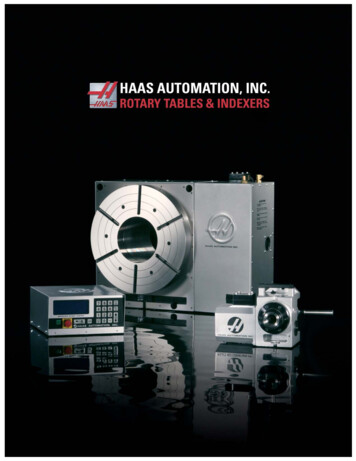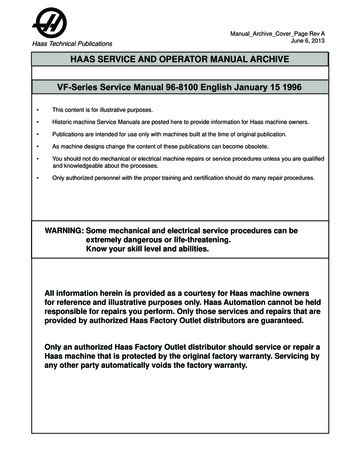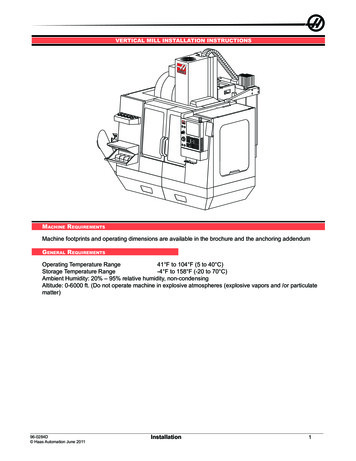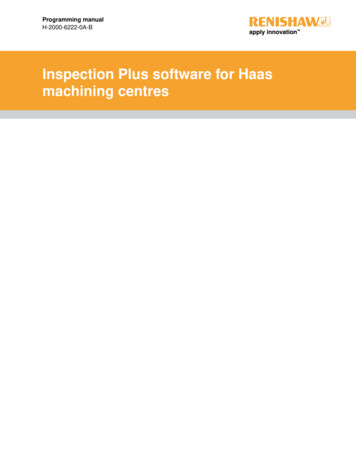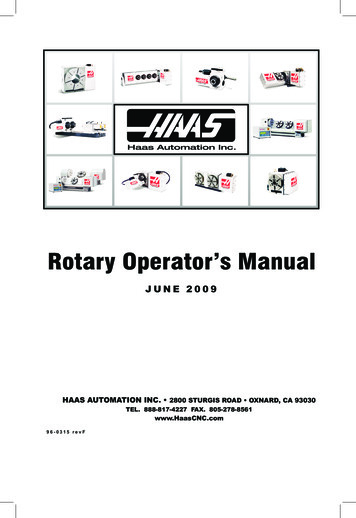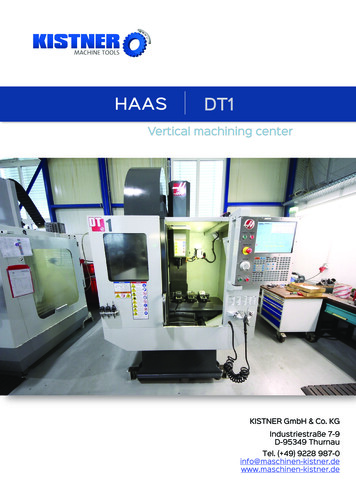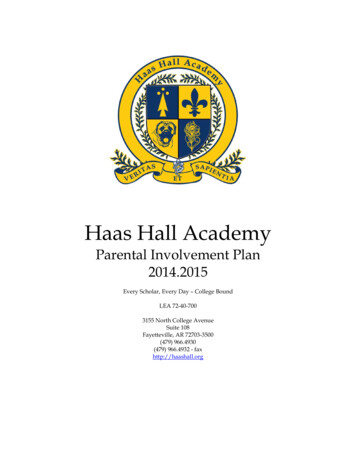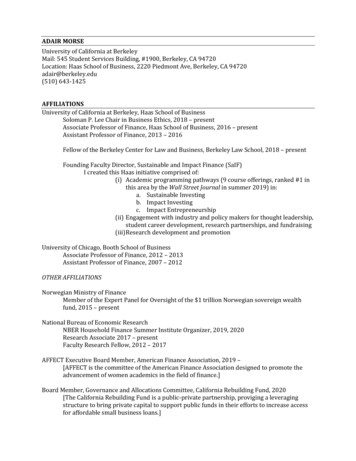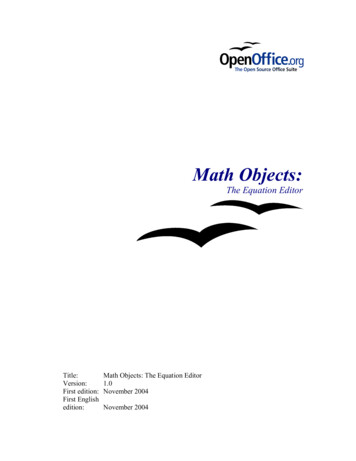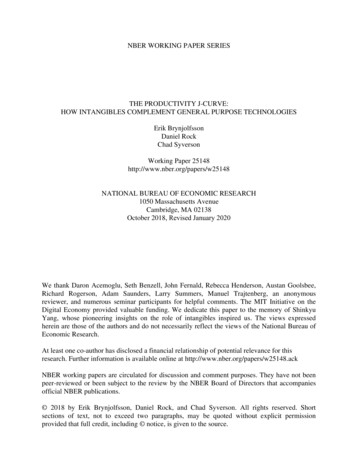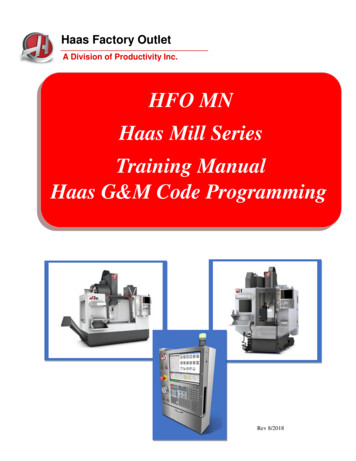
Transcription
Haas Factory OutletA Division of Productivity Inc.HFO MNHaas Mill SeriesTraining ManualHaas G&M Code ProgrammingRev 8/2018
This Manual is the Property of Productivity Inc.It may not be reproduced or disseminated without the express written permissionofProductivity Inc. The content must not be altered, nor have the Productivity nameremoved from the materials. This training manual is a guide for the operation ofthe Machine Tool.The Operator is responsible for following Safety Procedures as outlined by theirInstructor or the Manufacturers Specification. Downloading and/or other use ofthis manual does not certify the completion of the Training Course. This manual isfor reference only.For more information on Additional Training Opportunities or our ClassroomSchedule,Contact Productivity Inc. 763.476.8600 (800)328-3272 Toll FreeVisit us on the Web: www.productivity.comTo obtain permissions contact: trainingmn@productivity.comNote: Some of the content, images and screen shots included in this manual are taken fromHaas manuals, controllers and web information with permission from Haas Automation Inc.2800 Sturgis Road Oxnard CA 93030-89332
G&M Code Mill Programming Training ManualTable of ContentsINTRODUCTION . 5MACHINE HOME WITH WORK OFFSETS . 7WORK COORDINATE SELECTION . 8TOOL LENGTH COMPENSATION G43 . 9ABSOLUTE AND INCREMENTAL POSITIONING . 10THE CARTESIAN COORDINATE SYSTEM . 11WORD ADDRESS PROGRAMMING . 12PROGRAMMING . 14ALPHABET WORD ADDRESS ASSIGNMENTS . 15PREPARATORY FUNCTIONS (G CODES) . 19MACHINE FUNCTIONS (M CODES) . 23PROGRAM STRUCTURE AND FORMAT . 27PROGRAM FORMAT . 28MACHINE DEFAULTS . 29PROGRAMMING WITH CODES . 30PROGRAM STRUCTURE . 31LINEAR AND CIRCULAR TOOL PATHS . 33LINEAR/CIRCULAR MOVEMENT – CREATING TOOL PATH . 34INTERPOLATION COMMANDS . 35CIRCULAR INTERPOLATION (G02 AND G03) COMMANDS. 36CUTTER COMPENSATION (G41, G42). 43FORMULAS – TAPPING, SPEEDS AND FEEDS . 52DRILLING, TAPPING, BORING CANNED CYCLES . 53CANNED CYCLES . 54LOOPING COMMAND CYCLES . 72BOLT HOLE PATTERNS . 743
ADDITIONAL G CODES . 80MILLING CIRCLES WITH CUTTER COMP . 81THREAD MILLING . 82CIRCULAR POCKET MILLING USING G12 AND G13 . 83CIRCULAR PLANE SELECTION . 88INCH / METRIC SELECTION (G20, G21). 89SETTING WORK, TOOL OFFSETS THROUGH THE PROGRAM (G10). 90GENERAL PURPOSE POCKET MILLING (G150) . 91ENGRAVING (G47). 98SUBROUTINES (SUBPROGRAMS) . 103SUBROUTINES . 104EXERCISES . 106FINAL EXERCISES . 1104
IntroductionWelcome to Productivity, Inc., your local Haas Factory Outlet (H.F.O.) for the Mill Programming Class. Thisclass is intended to give a basic understanding of the programming of a Haas Machining Center.After 1945 design of wings for the US Air Force were becoming extremely complex and hard tomanufacture using conventional machine tools. MIT developed a machine that was able to control acutting tool path with a series of straight lines defined by axial coordinates at prescribed feed rates. Thefirst NC machine tool was introduced to the defense and aerospace industry by MIT in 1952. The contourof a constantly changing curvature could be described by a series of short lines determined by a series ofcoordinate in three axes.The first machine tools were run with instructions or programs punched out on paper tape. The files ofthe early machine tools were often in the format which later became known as G-code. The reason forthe name being that many of the lines of text began with the letter G.In an NC machine, the tool is controlled by a code system that enables it to be operated with minimalsupervision and with a great deal of repeatability. "CNC" (Computerized Numerical Control) is the sametype of operating system, with the exception that a computer monitors the machine tool.The same principles used in operating a manual machine are used in programming a NC or CNC Machine.The main difference is that instead of cranking handles to a position on a slide to a certain point, thedimension is stored in the memory of the machine control once. The control will then move the machineto these positions each time the program is run.The operation of the VF-Series Vertical Machining Center requires that a part program be designed,written, and entered into the memory of the control. There are several options for getting theseprograms to the control. RS-232 (serial port with a computer), 3.5” Floppy Disk, Ethernet / Networking/and USB are all viable ways to transmit and receive programs.In order to operate and program a CNC controlled machine, a basic understanding of machining practicesand a working knowledge of math are necessary. It is also important to become familiar with the controlconsole and the placement of the keys, switches, displays, etc., that are pertinent to the operation of themachine.This manual is intended to give a basic understanding of CNC programming and its applications. It is notintended as an in-depth study of all ranges of machine use, but as an overview of common and potentialsituations facing CNC programmers. Also use of the new Haas Control feature “Intuitive ProgrammingSystem” or (IPS) will be demonstrated. It will produce G-Code programs for simple machine operations.5
NOTES6
Machine Home with Work OffsetsThe principle of machine home may be seen when doing a reference return of all machine axes atmachine start-up. A zero return (POWER UP/RESTART) is required when you power on machine, all threeaxes are moved to extreme positive locations until limit switches are reached. The reason the machinedoes this is to double check its position with the “Home” switches of the machine.This is crucial to the operation and function of a CNC machine as all of our programs, fixturing, andtooling are based off of machine home.Above: The relationship of machine home to “work home”, otherwise know as “work offset”7
Work Coordinate SelectionWhat is a “Work Coordinate”?A work coordinate (otherwise known as a part offset) is how we tell the machine where our part (orparts) are located at in the travels of the machine. Under the Work Offsets page in the control, we handwheel the machine to the X & Y “Zero” location for our part, and use the “Part Offset Measure” key underthe Reset key to set the corresponding work offset from our program (G54, G55, G56, etc .)G54 – 59Work Offsets #1 – 6These are the first G-Codes that were assigned to work Coordinates. This is how we tell the machine thatwe are working on Part #1, Part #2, etc . thru Part #6. Originally no one thought we would need morethan 6 part offsets, but thru time and the invention of new types of machines, more were needed .G110 – G129G154 P1-P99Work Offsets #7 – 26 (Older Machines)Work Offsets #7-106 (Newer Machines)These codes are the same as G54 to G59; they add more places as X & Y zero. We now can set up to 99additional “zeros” within the travels of our machine.MORE WORK COORDINATE SYSTEM SELECTIONNote: The G52 command works differently depending on the value of Setting 33. This settingselects the FANUC, HAAS, or YASNAC style of coordinates, which are listed below.G52 Global Work Coordinate ShiftG52 will “shift” all work offsets that are set in the machine. In the Work Offsets page of the control, if weinput a value of X 1.0000, ALL of the offsets will move one to the right by a value of 1.0000. This is mostcommonly used in casting and forging work where we have core movement.G53 Positioning In Regards to Machine Home (Non Modal)G53 is used inside a program when we want to move the machine a certain distance and location fromMachine Home. This is quite often used if we want to establish a safe tool change position because wehave large parts or tools and need to clear the tool changer.G92 Set Work Coordinate SystemG92 Can be used to set our work offsets while “on the fly” in our program. G92 was used back whenmachines only had one offset to choose from. We had to cut our first part, move the spindle over to thesecond part X&Y zero, and then call G92 X0Y0 in our program. Our work offset is now set around thesecond part. Using G54 – G129 is much faster, more tunable, and easier to use.8
Tool Length Compensation G43G43 Tool Length CompensationG43 is the code we use to establish a tool length to the control. Upon setup, the operator will determinethe tool length and input that dimension into the Tool Offset Memory for that tool. Each tool in themachine will have a defined tool length, and this will be presented to the control in the form of an “H”value. (H1 is equal to tool length offset #1, H2 length offset #2, etc .)The programmed code would be:Canceling Tool Compensation (G49 or H00)To cancel tool length compensation, we can either use the code of G49, G28 (Go to machine homeposition) or use an H value of H00. M30 (program end) or depressing the reset button will also canceltool length compensation.9
Absolute and Incremental PositioningThere are two different systems used in positioning our machine. Both will “steer” the machine where weneed it to go, both can net the same results. The rea
This manual is intended to give a basic understanding of CNC programming and its applications. It is not intended as an in-depth study of all ranges of machine use, but as an overview of common and potential situations facing CNC programmers. Also use of the new Haas ontrol feature Intuitive Programming System _ or (IPS) will be demonstrated .File Size: 2MBPage Count: 116
